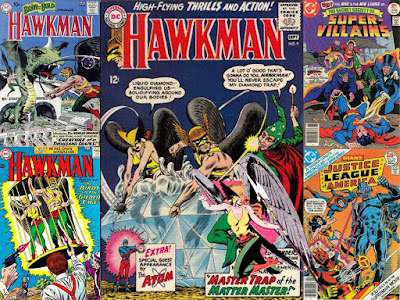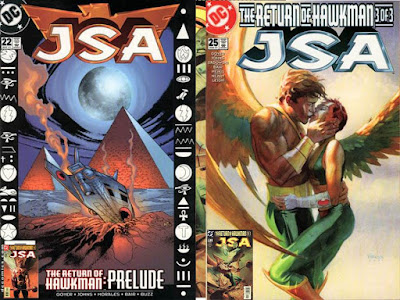Well, not so much. True, the Calculator might have been a villain to contend with, but he hardly struck fear into the heroes who faced him.
Let's take a look at the facts of his early cases, and see how things add up!
Crimes By Calculation
Detective Comics #463 (September, 1976 by writer Bob Rozakis, penciller Mike Grell and inker Terry Austin) saw the premiere of the Calculator, and he started off small, by facing the Atom!The Calculator was trying to steal a "quake-breaker" from scientist Richard Bagley at Ivy University, and he was quickly defeated by the Atom (but, the Calculator seemed happy about this as he pressed a button at his defeat....).
A Hot Time In Star City Tonight
The Atom told his friend and fellow Justice League member, the Black Canary about his case in Detective Comics #464 (October, 1976 by Bob Rozakis, penciller Mike Grell and inker Terry Austin), or at least he tried, as Black Canary wanted to get home to Star City for it's Tricentennial!After a mishap in getting home, the Black Canary faced off against the Calculator and an untimely heat wave in Star City (that the Calculator was causing by amplifying Black Canary's Canary Cry!). Luckily, she figured out a way to beat him, and did (though, again, the Calculator seemed happy as he pressed a button on his uniform in defeat).
The Elongated Plague
Next up for the Calculator is Detective Comics #465 (November, 1976 by Bob Rozakis, penciller Ernie Chan and inker Terry Austin), where the villain really decided to stretch his muscles, and face off against the Elongated Man!This time, Elongated Man and his wife, Sue Dibny, were guests of honor at the Star City Comic Con, where they faced off against an outbreak of elongated attendees....the people at the show all developed elongated powers they couldn't control (thanks to the Calculator). Still, Ralph Dibny was able to defeat the Calculator (who again, pushed a button, and seemed very happy in prison....).
Take Me Out Of The Ballgame
Detective Comics #466 (December, 1976 by Bob Rozakis, penciller Marshall Rogers and inker Terry Austin) saw hints of the Calculator's plan, as he attacks a baseball game in Star City.Green Arrow was scheduled to throw out the first pitch, but he just couldn't get the ball across the plate (and it was the fault of the Calculator). Elongated Man was a spectator at the game, and found himself unable to move to help Green Arrow, as the battling bowman used the Elongated Man as a bowstring to take out the Calculator (accidentally hitting the Calculator's special button himself).
The Man Who Skyjacked Hawkman
By Detective Comics #467 (January-February, 1977 by Bob Rozakis, penciller Marshall Rogers and inkers Terry Austin and Neal Adams), even Hawkman knew something bigger was happening, and he told Batman so.After Batman related his most recent case to the Thanagarian policeman, Hawkman told Batman of his battle with the Calculator, where he faced his foe at Midway City Airport, as Hawkman was taking a scientist off a plane to stop an atomic plant from melting down, but found his cargo to instead be the Calculator! Hawkman still defeated the villain, and saved the atomic plant (with the Calculator again pressing his button), but Hawkman came to Gotham to warn Batman that he might be the next victim of the Calculator!
Battle Of The Thinking Machines
Detective Comics #468 (March-April, 1977 by Bob Rozakis, penciller Marshall Rogers and inker Terry Austin) sees Batman face the Calculator as the villain tries to steal a time capsule being buried in Gotham, and Batman defeats him, with, yet again, the Calculator pressing his special button.Batman, after dealing with Metropolis WGBS head, Morgan Edge, goes to the Justice League Satellite, where the members talk about the Calculator escaping...AGAIN...and the heroes who faced him before have Aquaman (who was on monitor duty), beam them down to the Calculator's new target in Central City (where the Flash, the city's hero, is unavailable due to having time travelled into the future at this time). The Calculator....easily defeats the JLA!
Somehow, the Calculator's device would calculate all the tricks the heroes could use against him after one battle, and they would never be able to defeat him again! Batman doesn't believe this, so goes after the Calculator again when he strikes at S.T.A.R. Labs in Central City, and turns the tables on the Calculator, having the villain defeat himself! A truly fun series of tales, as writer Bob Rozakis finally answers the question he set up in all the previous Calculator stories (which, as DC's Answer Man, you knew he would!).
The Calculator Continues
Bob Rozakis brought the Calculator back a few times, first to face the Atom and Air Wave in Action Comics #522 to #524 (August to October, 1981, with penciller Alex Sauvik and inker Vince Colletta), then writer Len Wein, penciller Paris Cullins and inker Dell Barris have Blue Beetle deal with the Calculator in Blue Beetle #8 (January, 1987), and Bob Rozakis has the Calculator learn the value of being behind the scenes, as he faces off against the heroes of Hero Hotline in Hero Hotline #6 (September, 1989, with art by Stephen DeStefano and Karl Kesel).
The Calculator is just another face in the crowd in Justice League America #43, JSA #30, Flash #183 and Young Justice #51, before taking inspiration from the Oracle (the lady who led the Birds of Prey), and became a source for criminal information behind the scenes, helping villains during the Identity Crisis (and finally getting an alter ego, that of Noah Kutler), helping the villains against the Secret Six during Villains United and the Infinite Crisis, and being a thorn in the side of Oracle and Black Canary in Birds of Prey.
The Calculator proved that big things can add up from the smallest beginnings!

















































